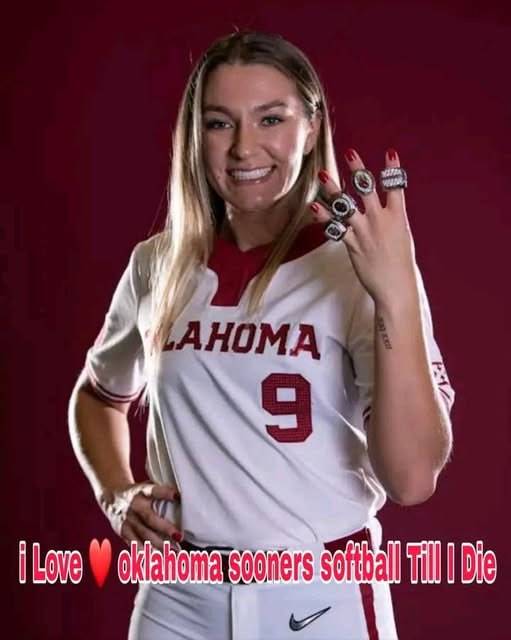
A Loyalty Unmatched: Kinzie Hansen Forges an Enduring Legacy by Rejecting $6.5 Million NIL Offer from USC
In an era where Name, Image, and Likeness (NIL) deals are redefining the landscape of college athletics, offering unprecedented financial opportunities to student-athletes, one particular decision has sent reverberations far beyond the diamond, encapsulating a profound statement on loyalty, commitment, and the enduring spirit of team over personal gain. Kinzie Hansen, the formidable catcher for the Oklahoma Sooners softball team, recently made headlines not for a walk-off home run or a game-saving throw, but for an astonishing act of defiance against the allure of immense wealth: she turned down a staggering $6.5 million NIL offer from the University of Southern California (USC). This decision, in an environment increasingly driven by financial incentives, stands as a powerful testament to the values that still resonate deeply within the heart of collegiate competition, painting Hansen as a beacon of unwavering dedication to her team and program.
The advent of NIL has undeniably transformed college sports, allowing athletes to finally capitalize on their marketability, a right long debated and finally granted. For many, it has meant life-changing money, an opportunity to provide for families, and a chance to build a financial future while pursuing their athletic dreams. Schools, eager to attract top talent, have leveraged NIL collectives and lucrative partnerships to create enticing packages, turning recruitment into a high-stakes bidding war. In this new reality, the expectation often leans towards athletes pursuing the most financially beneficial path, making Hansen’s rejection of such a colossal sum from a rival institution all the more extraordinary and, frankly, inspiring. The $6.5 million figure is not merely a substantial amount; it represents a sum that could set up a young person for life, offering a level of financial security that very few individuals, let alone college students, ever achieve. To walk away from that, especially when the alternative is to remain with a program that, while incredibly successful, might not be able to match such an astronomical offer, speaks volumes about Hansen’s character and her priorities.
Hansen’s roots with the Oklahoma Sooners run deep, intertwined with a dynasty that has consistently dominated college softball. She has been an integral part of multiple national championship teams, contributing significantly with her exceptional defensive skills behind the plate and her powerful bat. Her journey with the Sooners has been one of shared triumphs, grueling practices, and a bond forged through countless hours of dedication with her teammates and coaching staff. This profound connection, nurtured over years of hard work and collective pursuit of excellence, appears to have weighed far more heavily in her decision-making process than any financial enticement. It’s a narrative that harkens back to a more traditional view of amateur athletics, where the pride of representing a school, the camaraderie of a team, and the pursuit of championships superseded individual financial gain. In an age of free agency in college sports, her choice is a refreshing anomaly, reminding everyone that the human element of loyalty and belonging still holds immense power.
The impact of Hansen’s decision extends beyond her personal finances and her individual legacy. It sends a clear message to the entire college athletics community. For Oklahoma, it reaffirms the strength of their program’s culture, demonstrating that their environment fosters a commitment that transcends monetary value. It suggests that the Sooners offer something invaluable that money cannot buy: a sense of family, a winning tradition, and a deep-seated pride in wearing the crimson and cream. This level of loyalty, publicly demonstrated, can be a potent recruiting tool, attracting future athletes who prioritize a similar collegiate experience over simply chasing the largest NIL deal. It also validates the efforts of coaches like Patty Gasso, who have meticulously built a program founded on principles of teamwork, sacrifice, and an unyielding pursuit of collective greatness. Hansen’s choice is a testament to the success of that philosophy, proving that even in the face of unprecedented financial temptation, the core values of the Oklahoma softball program remain unshakeable.
For USC, the rejection is undoubtedly a setback, a public acknowledgement that even with significant financial resources, some athletes cannot be swayed from their established allegiances. It highlights the challenge that schools face in trying to build programs through the transfer portal and NIL acquisitions when dealing with athletes deeply entrenched in successful and meaningful environments. It’s a reminder that while money can open doors, it cannot always buy the inherent bonds and loyalty that are cultivated over years within a tight-knit team. USC’s ambitious offer was a clear signal of their intent to elevate their softball program, but Hansen’s steadfast refusal underscores the complex human dynamics at play in the NIL landscape.
Furthermore, Hansen’s decision provokes a broader discussion about the long-term implications of NIL on collegiate sports. While NIL has provided much-deserved compensation for athletes, there are ongoing concerns about its potential to create a transactional environment, eroding team cohesion and fostering a “free agent” mentality that prioritizes individual wealth over team success. Hansen’s act serves as a powerful counter-narrative, suggesting that the spirit of loyalty and genuine passion for a team can still triumph over even the most lucrative offers. It offers a glimpse of hope that while NIL is here to stay, it may not completely dismantle the traditional values that have long defined college athletics. Her choice challenges the prevailing notion that every athlete will, or should, follow the money, providing an example of an athlete prioritizing her existing relationships, her role within a winning culture, and the unfinished business she perceives with her current team.
Kinzie Hansen, by turning down an offer that could have set her up for life, has cemented her place not just as an exceptional athlete, but as a rare example of profound loyalty in a rapidly changing athletic landscape. Her decision resonates deeply with fans and pundits alike, offering a compelling narrative that transcends statistics and championships. It’s a story of unwavering commitment, a testament to the power of shared goals, and a powerful statement that some things, even in the modern era of college sports, are still worth more than money. In doing so, she has not only solidified her legendary status within the Oklahoma Sooners program but has also provided a poignant reminder of the enduring strength of team loyalty in an increasingly monetized world. Her unprecedented rejection will undoubtedly be remembered as a defining moment, a pivot point in the ongoing evolution of Name, Image, and Likeness, showcasing that genuine allegiance still holds an invaluable currency in the heart of collegiate compete



